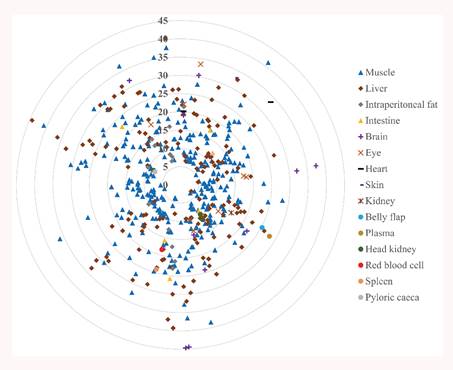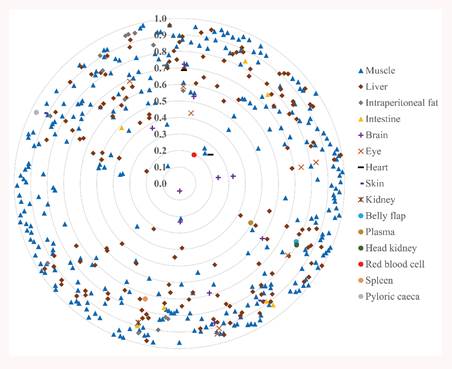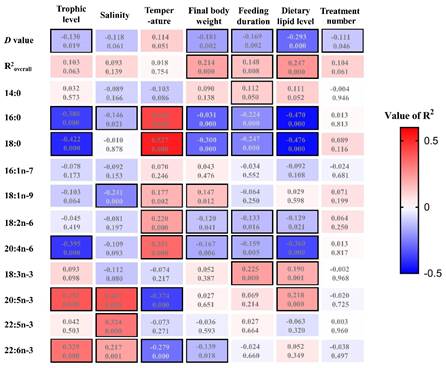Sep. 30, Aqua-Nutrition and Feed Team of Yellow Sea Fishery Research Institute (YSFRI) published a paper entitled “Are fish what they eat? A fatty acid’s perspective” on the top journal Progress in Lipid Research. This work lasted for 3 years and was accomplished with the collaboration among YSFRI, Ocean University of China, Deakin University, and CSIRO Australia. This work quantitatively summarized the ‘diet-fish’ FA relationship via an analysis of FA composition in diets and fish tissues from 290 articles published between 1998 and 2018. Comparison of this relationship among different fish species, tissue types or individual FA was summarized. Furthermore, the influence of environmental factors such as temperature and salinity, as well as of experimental conditions such as fish size and trophic level, feeding duration, and dietary lipid level on this relationship are discussed herein. This work is beneficial in providing a more comprehensive understanding of the fundamental relationship between the FA composition in diets, and subsequently, in the farmed fish. Such information is integral to maintaining the quality of farmed fish fillets from the perspective of FA composition.

Figure 1 Radar distribution of D values, which indicate the distance (disparity) between fatty acid compositions of diet and fish tissue.
Fish are the main source of long-chain polyunsaturated fatty acids (LC-PUFA, >C18) for human consumption. The deposition of FA into fish tissues has an inherently high level of plasticity. In general, it has been widely observed that the fatty acid (FA) profiles of farmed fish are reflective of the diet. However, the degree of tissue FA “distortion” based on incorporation of different dietary FA into fish tissues varies greatly depending on FA type, fish species and environmental factors.
In this work, the ‘diet-fish’ FA relationship database was constructed based on analysis of FA composition in diets and fish tissues from 290 articles published between 1998 and 2018. For each individual FA in each study, the following four statistical parameters were calculated, each considered characteristic in describing the ‘diet-fish’ fatty acid relationship: (1) Two-tailed Pearson correlation analysis between FA content of diets and fish tissues; (2) Relative inter-treatment Standard Deviation of FA content; (3) Average FA content in the fish tissues, combining all treatments; (4) Raletive Average FA Content of all treatments. Besides these four descriptive parameters, another two parameters were calculated for each tissue in each of the selected studies: Coefficient of Distance (D) and R2overall. SIMPER analysis using a Bray-Curtis similarity matrix in PRIMER was used to analyse dissimilarities between diet and fish tissue FA composition. In order to further evaluate the ‘diet-fish’ fatty acid relationship, Pearson correlation analysis was conducted between each experimental condition and individual FA content in the muscle, as well as D and R2overall values. Via a systematic review and subsequent quantitative analysis of FA data, the present review presented, and discussed in detail, these highly variable and complex ‘diet-fish’ FA relationships, which will benefit the fatty acid management if fish diets and fish products.

Figure 2 Radar distribution of R2overall values, which are the Pearson correlation coefficient between fatty acid matrixes of diet and fish tissue.

Figure 3 Pearson correlation between experimental conditions and muscle FA attributes, across all the 290 studies.
Houguo Xu from YSFRI is the first author of this paper; Giovanni Turchini from Deakin University, Mengqing Liang from YSFRI and Qinghui Ai from Ocean University of China are co-corresponding authors of this paper. This work was supported by National Key R&D Program of China, National Natural Science Foundation of China, and China Agriculture Research System.
Progress in Lipid Research is a top journal in the lipid research area (IF=15.083), which focuses on the latest advances in lipid research. It publishes only 25 papers each year.
The article is available at:
https://linkinghub.elsevier.com/retrieve/pii/S0163782720300448
